The baby’s arrival to the community
To assess and celebrate
• How was the visit to the Health Service?
• Do you have any doubt about the pre-natal check?
• How became the delivery plan you made?
• Is there any message, prayer or biblical quotation that celebrates the gift of life and the acts that we performed with our next, the pregnant women and their families? One suggestion is:
Sweet is to feel
(song from the film Brother Sun, Sister Moon)
Sweet is to feel in my heart that love
humbly is being born.
Sweet is to know that I am not alone.
I am part of an immense life,
that generous shines around me
Immense gift of your endless love.
The Heaven you have given us and the bright stars
Our brother, Sun, our sister, Moon
Our mother earth with fruit, fields, flowers
The fire and the wind, the air, the pure water.
Source of life of your creature,
Immense gift of Your endless love.
To See
The baby in the first week of life
1. Are the mothers of your community willing to breastfeed?
2. How do the families of your community get prepared for the baby’s arrival to their home?
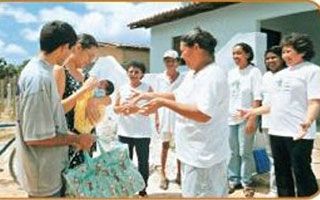
Foto:
The mother and the baby go home! May their arrival be celebrated in the family and in the community.
Oh God, all the community thank You for the gift of life.
May this child be the symbol of the presence of the Lord our God.
May this child grow breastfed
in the knowledge and in the love to God and to the next.
May his/her parents give him/her the example of faith
and teach him/her the Word of God.
May the peace, the good, the love and the tenderness
dwell in his/her heart.
Amen.
The parents have the responsibility to accept with love the task of taking care and raising their child. And they should do this according to their values, habits and faith.
One of the first demonstrations of faith is to introduce their child to their religious community. In the catholic families, Baptism is the sign of a person’s admittance to the community of God’s children.
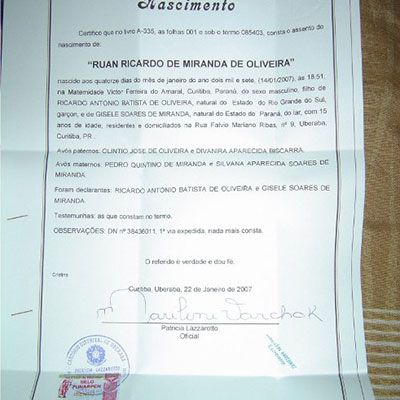
Foto:
Does the baby have the Birth Certificate?
Leader, ask the family if they have already registered the child’s birth and obtained the Birth Certificate, which is the first document of the child as a citizen. If they still have not done so encourage the father of the family to register the baby soon. But for the child to become a citizen he/she also needs that her/his family, the community where he/she lives and the whole society to ensure her/his rights.
It is written in the 4th Article of the Brazilian Statute of the Child and Adolescent:
It is the duty of the family, the community, society and the public power in general to ensure, with absolute priority the enforcement of the rights to life, to health, to food, to education, to sport, leisure, to professionalisation, to culture, to dignity, to respect, to freedom, to family and community intimacy.
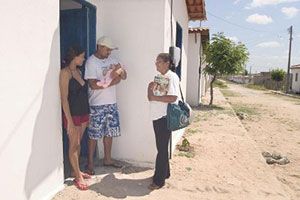
Foto:
Leader, now that the mother and the baby have arrived home, the family may need very much your help. Your presence is very important, for it is at the home visit that you detect whether the mother and the baby are well. And you do this by talking to her, giving support and identifying situations in which you can be of help.
In the first seven days of the baby’s life, it is recommended that you visit the family more times, mainly if the couple has no close relatives. This period is the most sensitive because diseases may appear very fast and those may be very serious. Besides that, the mother is still recovering from the labour.
When the baby is the first child the parents might feel insecure, for they are beginning to learn what it is like to be a father and a mother. The couple that has already other children also needs to be given support.
Leader, your support to encourage the mother to breastfeed is precious!

Foto:
Does anybody help home so that the mother can take care of the baby?
The mother is more sensitive and needs to be available for the baby at all times. Her mood and her feelings swing; she is either calm or nervous; she feels either happy or she feels sad. She might become worried because she feels she is not able to take care of the baby or restless because of the other children she already has.
She needs the help and understanding of the partner and of the other people so she does not get tired and can take care of the baby. If the people help her with the housekeeping and taking care of the other children, she gets less tired. Talking to someone about what she is feeling also makes her feel calmer and safer. Single mothers/ or women without partner need even more the support from other people.
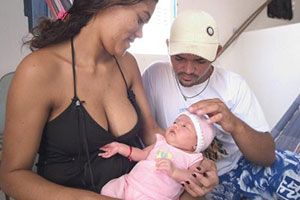
Foto:
Leader, in these first days, watch for the relationship between the mother and the baby. You can do that by observing how the mother takes care of the baby, how she changes the diapers, how she bathes and feeds the baby.
The mothers who take care of the baby willingly and happily, cuddling and smiling to the child show that the relation is beginning to work all right.
In the first days after the birth some mothers may become sad and unwilling to take care of the baby for a while.

Foto:
It is important to gently and tenderly encourage the mother to care of the baby. Talk also to her partner and to the family and stimulate them to observe the relationship between the mother and the child. When the mother’s sadness does not diminish or worsens it is necessary to take her to the Health Service for the doctor to check her condition and prescribe her a proper treatment.
The father of the baby may also become more sensitive, anxious and feel abandoned. The reason is that all attention now is given to the baby and to the mother. And he may fear that he does not know how to help to take care of the baby.
Leader, talk to the father and show that he is important, encouraging him to help with the baby’s care. It is good to encourage the mother and the father to talk to each other about their doubts and concerns.
The support from the leader, from friends and the community strengthens the solidarity and helps the parents to create a safe, loving and healthy environment for the baby.
“No foul word should ever cross your lips; let your words be for the improvement of others, as occasion offers, and do good to your listeners.” Eph 4:29
Breastfeeding
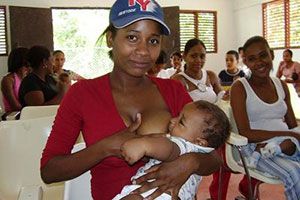
Foto:
Leader, in these first days, your help is of much value. Encourage the mother showing her how to better breastfeed. Try to solve with her and the family the difficulties which may arise.
Breastfeeding must be pleasant to the mother and to the baby. There are several good positions to breastfeed. In one of them:
• The mother holds the baby buttocks with her hand;
• The baby’s head is supported on the folded part of the elbow;
• The baby’s tummy is put very close to the mother’s body.
Baby’s right sucking position
Show the mother how is a right sucking position so as the baby sucks well and does not hurt her breast. For this to happen:
• The baby has to be awoken;
• The mouth of the baby must snap/ catch all the nipple and most part of the areola, which is the dark part around the nipple;
• The lower lip of the child should be turned out;
• The baby’s chin should touch the nipple.
The baby usually sucks, give a break and then suck again. The mother can hear the baby swallowing the milk.
Even when the baby sucks in the right position, the mother can feel some sharp pain in the beginning of breastfeeding; this is the baby pulling the nipple.
There is not a right time for breastfeeding. Some babies “devour” the milk fast, others suck it very slowly. The new born babies use to take 15 or 20 minutes to be fed. This time is enough for the baby to receive all nutrients from the milk.


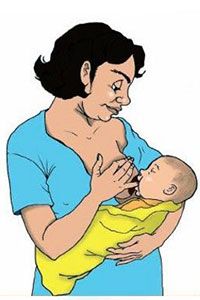
Foto:
In general the babies do not manage to empty both breasts. It is important to let the child empty very well one breast before changing to the other. If the baby does not want to suck it means he/she is already full.
When you take the baby from the breast the mother shall put the little finger on the corner of the baby’s mouth. Doing this makes the baby loose the nipple without hurting the breast.
After being breastfed the baby should be put on a standing position on the lap with the back and the head well supported. If the baby swallowed some air he/she will eructate. It is not necessary to beat on the baby’s back or to toss the child.
Leader, teach the mother to start each new breastfeeding session:
• With the breast which the baby has not sucked before; or
• If the baby has sucked both breasts, to begin with the one he/she last sucked.

Foto:
In order to keep the breast clean for the baby, it is enough that the mother takes a shower everyday and changes the bra whenever it is wet.
In the end of breastfeeding, in order to protect the breast, the mother should take one or two drops of her milk and pass on the areolas and on the nipples, then let it dry before getting dressed. The fat of the milk makes a protection layer against the bacteria and lubricates the skin, protecting the nipple of the breast against cracked nipple.
The mother’s milk must be given whenever the baby asks. This makes the baby put on weight faster.
The baby who is breastfed does not need to take tea or water. Thirstiness is solved with the milk alone even in very warm and dry places.
The baby who is not only breastfed is subject to suffer from more infections such as diarrhea and pneumonia.

Foto:
When the mother says she has not much milk or that is having difficulties to breastfeed it is necessary to check what is happening:
• Is the baby put in the right sucking position?
• Is the baby having water, tea or any other type of milk besides the mother’s milk?
• Is the baby breastfed whenever he/she asks for it?
• Is the mother going through any difficulty?
• Does her partner encourage and give her any support so she can breastfeed?
• Have all other family members, friends and neighbours been helping the mother throughout this stage?
Difficulties may appear, especially when it is the first child and the mother has not had much experience or if the mother has faced problems to breastfeed her other children. These women need more support from the family and from you, leader.
There is no weak maternal milk. When the mother becomes tired or annoyed the milk may be less produced. Tell the mother to drink more liquid, eat well and rest more.
It is recommended to explain to the parents that every baby loses a little weight in the first days of life. Then through breastfeeding the baby’s weight will increase. The more the baby sucks the more milk the mother produces.
Every baby has his/her own feeding and sleeping pace. The parents can identify whether the baby is sucking enough when he/she pees or defecates several times a day. The pooh is usually soft, yellow, greenish yellow and in small quantity. This is not diahrrea.
The father cannot breastfeed but he can give support to the mother. Thus, he strengthens his paternal connection with the baby. He can, for example, bring the baby to be breastfed, put the baby for eructation, change the diapers, talk and sing to the baby.
Leader, it is important to be closer to the mother in the beginning of breastfeeding. Follow at least two breastfeeding sessions to see if the baby sucks in the right position and help to quieten the mother at this moment.
“Blessed the womb that bore you and the breasts that fed you!” Luk 11:27
Common breastfeeding problems
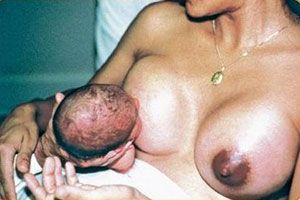
Foto:
Some mothers may have difficulties to breastfeed. When this happens it is necessary to give them more support and guidance.
The unpleasant feeling in the breasts (hardened breasts) may happen in two situations: when the mother produces more milk than the baby needs or when the baby does not suck enough to empty the breast. This may occur several days after the labour.
When the breast is hardened the teats become hard and full. The milk accumulates and gets thick. This makes it difficult to get out and some stones can be formed.
When the breasts are full the baby does not manage to suck in the right position, causing pain to the mother and irritation to the baby. Therefore it is important that the mother takes out the milk from her breasts (milking procedure).
Leader, to prevent hardened breasts, it is recommended that the mother:
Begin breastfeeding as early as possible;
Breastfeed the baby whenever he/she asks, emptying the breasts as much as possible, one at each time;
Breastfeed with baby put in the right sucking position; Do not give other food or liquid to the baby before six months of age; Always wear bra
.
In case the breasts become hardened, you can help the mother to take the milk doing the milking procedure (consult this Guide on page 170).
Leader, if the mother is nervous, find a way to quieten her in order to help the milk to come down.
Cracked nipples
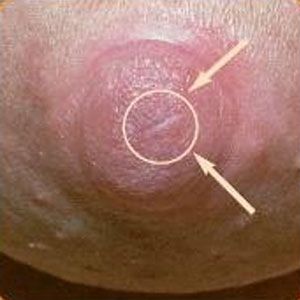
Foto:
The cracked nipples are the most common cause of pain in breastfeeding. It happens when the baby is wrongly put on the lap and when the baby is put in the wrong sucking position
In order to prevent cracked nipples, the mother should:
• Breastfeed with baby put in the right sucking position;
• Pass her milk on the nipples after breastfeeding and have the milk dry well before getting dressed;
• Not use any products on her breasts;
• Not leave any wet pad on the breast;
• Not use any nipples protection;
• Before breastfeeding, if the breast is too full, do the milking procedure.
If the mother even though, gets cracked nipples apart from the cares mentioned above, it is necessary that:
• The baby be put for sucking as soon he/she asks for it so that the baby does not suck with excessive strength;
• The breast be massaged before being offered to the baby to facilitate the milk to come down;
• First offer the breast which is less sore to the baby;
• The breastfeeding position is changed, like it is shown in the photos;
• Keep the breast always dry;
If possible, the breasts should be daily exposed to the sun for a maximum period of 15 minutes, in the beginning or end of the day.
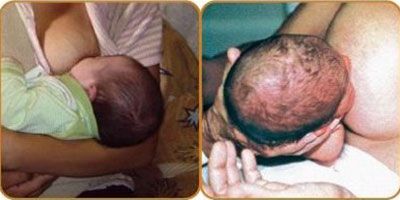
Mastitis
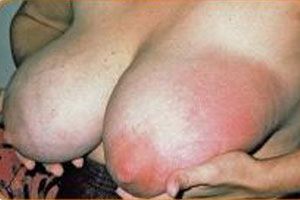
Foto:
Mastitis is an inflammation of the breasts that may or may not be become an infection. It results from the hardened breasts or from cracked nipples. In the mastitis the affected part of the breast gets painful, red and hot. When there is infection the mother may have high fever (over 38º C) and chills.
Since mastitis is caused by hardened breasts or cracked nipples, the main cares are:
• Breastfeed with baby put in the right sucking position;
• If the baby does not empty the breasts, empty the breasts by doing the milking procedure.
When the mother has mastitis it is advised that she go to the doctor and be guided to follow the correct treatment. If she takes too long to start the treatment, a wound with pus can be formed and then the treatment becomes more complicated.
SHow the baby can learn and grow
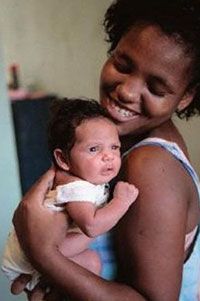
Foto:
Since pregnancy the way the parents relate to the baby already shapes in him/her the way he/she is going to be. In the last pregnancy months, the baby listens to songs, reacts to strong light close to the mother’s belly and may feel when she is very tired or nervous.
Before being born, the contact of the baby with the mother is direct. It is from her the child receives food, heat and comfort in the belly. When the child is born all these known sensations disappear rapidly, and the baby will have to get used to a new environment.
Tender look, sweet words, delicate touches and comfort in the lap of the parents make the baby feel loved and protected.
The baby communicates his/her needs mainly by the cry. He/she cries of hunger, of pain, of cold or hot, asking for comfort and because he/she is wet. As soon as he/she is taken cared of the baby learns that someone takes care of him/her. Little by little the parents learn to identify the baby needs and then can help him/her to develop better.
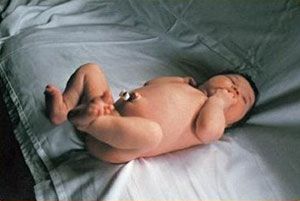
Foto:
The baby spends most of the time with the arms and legs folded and the hands closed as he/she used to be in the mother’s belly. It is also common the baby eructates, sobs, coughs a little and make some little noises. These things are part of the baby’s life.
The baby stirs a little and almost always reacts the same way to some stimulus. For example: when we put the finger in his/her hand he/she grabs it with strength; when the baby is touched, listens to some noise or we take his/her clothes off, he/she makes a movement like she/he is embracing or frightened.
The baby sleeps most of the time. Sleeping the baby accumulates the necessary energy to suck and grow. Some babies have a lighter sleep others a heavier one. The sleep of the baby that is more tenderly touched by the parents is usually more peaceful.
Hygiene
Alinhada à esquerda - vertical
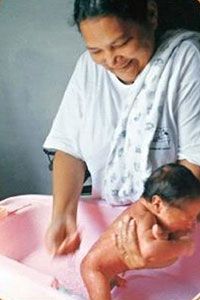
Foto:
Hygiene is important because it protects the baby against diseases and makes the baby feel well. The mother’s hands or of whom takes care of the baby should always be clean and the nails short.
To facilitate the bath time it is good to let everything prepared before putting the baby in the water. It is necessary to check if the water is not too hot. This can be made by putting your elbow in the water and feeling if the water temperature is comfortable. This prevents burns.
The face and the head shall be washed before putting the baby in the water. This prevents that the leftovers of pee and pooh contaminate the water and cause inflammation in the baby’s eyes.
The baby needs to be hold firmly not to get scared. In order to facilitate it is good to support the baby with one arm and wash him/her with the other.
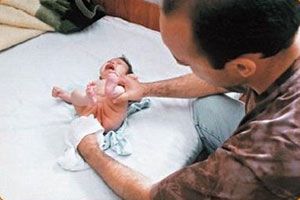
Foto:
The skin folds of the neck, the arms and the legs should be wiped to avoid galls. It is advisable to separate a soft tissue or towel only for the baby. The talc does not need to be used because it has no use. The baby has to be dressed with comfortable clothes and that do not tighten his/her movements.
Each time the diaper gets wet it needs to be changed. The baby’s buttock should be cleaned, washed and wiped well each change of diaper. This prevents galls and infections.
To clean the baby girls the wet tissue should be passed in the vulva (the external genitals) from the front to the backside. This care avoids that the faeces contaminate the vagina and the pee little hole.
To clean the baby boy it is important to pull back the skin of the penis gently, cleaning well the leftovers of urine and faeces which might be between the skin folds. This avoids infections.
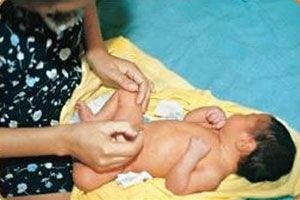
Foto:
The umbilical cord usually falls within 14 days from the childbirth. The bandage of the umbilical cord should be changed every day till the belly button falls. The best product to use is alcohol 70%. This alcohol can be bought at the drugstore/chemists or obtained at the Health Service.
In order to make the bandage it is necessary to wipe well the belly button after the bath and pass on a wet plaster deepened in alcohol 70% on it. It is not advisable to put on adhesive plaster, a band made of cloth or a soft belt around the umbilical stump. Those would prevent the baby from breathing and the belly button from falling.
Attention: if after the belly button has fallen some bleeding, red skin or bad smell in that place it is necessary to take the baby to the doctor immediately.
In some babies it may appear some white spots in the mouth, which look like clotted milk. This can be thrush. The treatment is made as follows:
• One glass of very clean water;
• One pinch of bicarbonate of soda (baking soda);
• Wet a clean tissue in this liquid and clean the mouth of the baby before breastfeeding;
• Wet the other end of the tissue and clean the nipples and the areola before and after each breastfeeding;
• After the tissue has been used it should be thrown away.
It is recommended to take the baby to the doctor if the white mouth does not disappear.
Signs of Danger for the baby’s Health from the birth till the second month
Leader, it is important that the family members know how to identify the signs of danger for the baby’s health. Instruct them to watch for them and to go to hospital if the baby shows any of those:

Home Visit
In these visits it is important to:
Ask how the childbirth was;
Deliver, read and talk to the mother abut the Love Bonds Cards: “the baby in the first month” and Signs of danger for the baby till the second month;
Talk about breastfeeding and observe the baby´s right sucking position (page 112);
Leader, in the first visits still ask: How the bandage is being made in the umbilical cord;
If the baby has been weighed in hospital and, in case he/she has not, instruct the mother to take the baby to the Health Service to be weighed;
If the hospital filled in and delivered the Child’s Health Card;
If the baby has taken the BCG vaccines and against Hepatitis B;
If the Guthrie Test has been made;
Register this baby in the Leader’s Notebook on the same page as the mother’s and answer to questions 1 and 2, according to the explanations of page 141.
Task suggestion for this qualification stage:
Visit one baby to observe breastfeeding.
Think of ideas to encourage breastfeeding.



